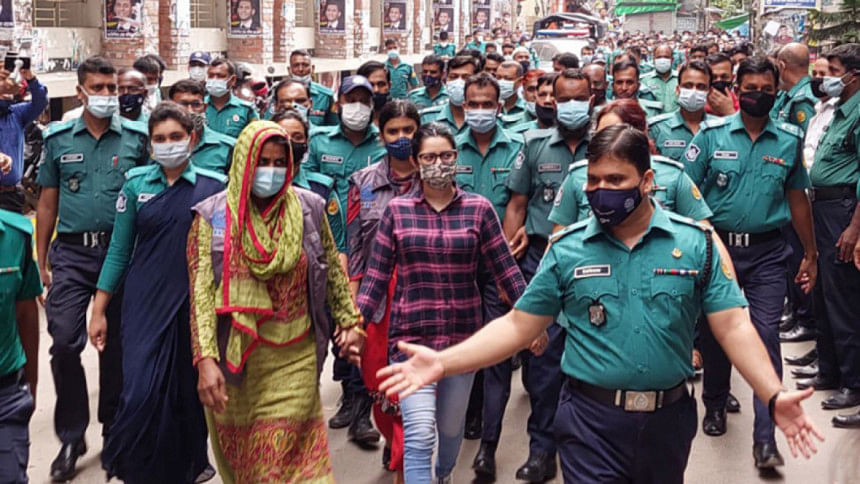Mirror, mirror on the wall, who are we laughing at?

Some of us are born entertainers. It can be a boon or a curse, as the fallen star Pori Moni is now finding out. Even in her darkest hour, she has her audience held in rapt attention. People are keenly waiting to know what happens next. Every tiny detail is gratefully accepted, and summarily dissected.
A "prostitute", a "derailed woman", a "seductress", an "addict"—these are just some of the adjectives that are being thrown around to brand this Dhallywood actress. Narratives surrounding her so-called salacious life have been dominating both social media and conventional forums ever since her very publicly-played-out arrest on August 4 by the country's elite security force, Rapid Action Battalion (RAB), on allegations of hoarding liquor, drugs and making pornographic videos.
Some civil society members have tried to assess the situation from an objective perspective—albeit cautiously—but the majority of the public seemed to have condemned Pori Moni for her "immoral" vagaries. While all the speculations surrounding what she did or did not do make for juicy gossip, perhaps it would be more worthwhile to reflect on the situation from a broader perspective and understand how our society commodifies women—packaged for the consumption of those who can afford it. Shamsunnahar Smriti, her real name, was an orphan living an ordinary life in a remote district, far away from the glitz and glamour of Dhaka's entertainment industry. She came to the capital in 2011, secured an offer for modelling, and then got her film break on the silver screen. She became a popular face in the Bangladesh showbiz industry, earned a good living, lived a lavish life in an upscale neighbourhood, and made some influential friends.
Things had been going pretty smooth for her until she ruffled up some influential feathers in recent months, which turned some of her friends into foes. Then, suddenly, she became the conniving villain of a criminal plot. She was, we were told, part of a blackmailing racket—a group of "loose" women—who allegedly seduced unsuspecting men with their wily charms and made compromising videos and then blackmailed the helpless victims into paying for their silence.
While the wider society is accusing Pori Moni of being immoral—somehow women facing legal issues often end up being questioned for their perceived lack of morality and judged guilty even before a court verdict—nobody is talking about what aided her transformation. Even if the stories being told about her are true, there is a clear demand in our society for the services of people like Pori Moni. We have all by now various snippets of the sleazy underbelly of the supply side, but how is it that the demand side is missing completely from the spotlight? Who are on the demand side? This is a question that must be asked if we want to make a fair assessment of the still-largely-one-sided narrative we are being fed.
Consider this: if Pori Moni's life were a movie plot, she could have been both its protagonist and antagonist, depending on the lens we look at her through. This could have been the story of a young woman's journey through life—the story of a self-made woman who has overcome myriad social struggles to achieve her dreams of being at the centre of limelight, but was led astray or victimised by a group of powerful men for whom she had become a nuisance. After all, in a male-dominated society, who likes a woman who questions the acts and wills of powerful men—let alone her patrons—or alleges them of attempted rape!?
Or, that plot could have been about a scheming temptress, who entraps innocent men with her devilish wiles and leads them into a life of dark temptations for her own nefarious ends. It is all a matter of perspective: the plots we choose to consume, the discourses we indulge in.
But right now, instead of turning Pori Moni's life into a circus—digging down deep into the lurid details, watching the leaked personal videos and making dirty jokes about her—perhaps we should be asking ourselves about the contours of the narrative we are choosing to indulge in at our dinner tables, in our living rooms, in our newsrooms, on our social media feeds. Why are these shaped the way they are?
There have been many women entertainers who have been in this situation before, enduring a harsh media trial, scathing social slanders, and there will be more in the future. This is how it is. This is how the social system operates.
If we want to break this vicious cycle of exploitation, we need to take a good hard look at ourselves first. Unless we learn to objectively assess our roles in creating such a marketplace and act proactively to dismantle this system, more women will be turned into commodities. More women will become victims of our flawed social perspectives.
Whichever narrative route our own personal Pori Moni movie is leaning towards—Pori Moni the fallen star, or Pori Moni the vile seductress—it is a tragedy either way. It is a very human tragedy, feeding off human frailties that have been the inspiration for ancient bards and modern novelists alike. But before we jump to conclusions, perhaps we could take a moment from our busy lives and ask ourselves: aren't we also somehow culpable?
Tasneem Tayeb is a columnist for The Daily Star. Her Twitter handle is: @tasneem_tayeb

 For all latest news, follow The Daily Star's Google News channel.
For all latest news, follow The Daily Star's Google News channel. 



Comments